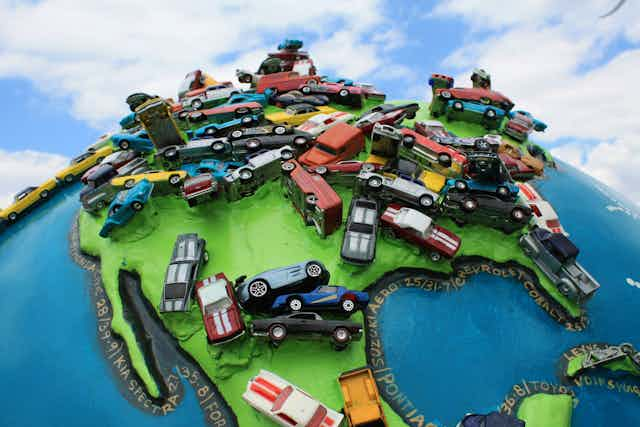Mathematics may not be the first thing your mind turns to when you are caught in a traffic jam. Yet mathematics holds the key to understanding how traffic congestion develops, and how to prevent it.
Perhaps one of the best known (and most surprising) mathematical results concerning how traffic flows around a network is Braess’s paradox. In the context of a road network, this is the seemingly counter-intuitive result that even without an increase in traffic, building a new road can actually make every single journey slower.
This can arise because the distribution of cars in a network is determined by the individual decisions of many drivers, each acting to reduce their own personal travel time instead of working as a group to reduce travelling times overall. Such behaviour often results in suboptimal use of the road network.
In fact, closing roads can even improve traffic congestion.
This highlights that there is a lot of very interesting, challenging, and important mathematics that is involved in efficiently transporting human beings around a modern city.
For example, how should public transport be scheduled to minimise people’s travel times? How should traffic signals be operated to reduce congestion? When and where should we build new roads?
Maths holds the answers

As populations continue to increase, tackling the transportation problem becomes ever more challenging. Mathematics has recently yielded some significant wins, however.
For example, mathematical control of the traffic lights at the entrances to Melbourne’s M1 freeway has already increased travel speeds on the M1 by 25% during the morning peak hour. And this was achieved without the cost of building extra lanes.
As regular commuters know all too well however, significant challenges remain. The term “rush hour” now seems quaintly old-fashioned; morning traffic congestion in Melbourne lasts from 6.30am until 9.30am.
The annual cost of congestion to Victoria is estimated to rise from A$3 billion to A$6 billion by 2020. In addition to these economic costs, there is also the negative impact congestion has on the environment, and on people’s quality of life.
Luckily, there are researchers around the world working on these issues.
A new field: jamology
One of these researchers is Katsuhiro Nishinari from the University of Tokyo. Nishinari played a pioneering role in trying to understand the fundamental behaviour of traffic flows from the perspective of theoretical physics and coined the term “jamology”.
His recent work focuses on studying flows of “self-driven particles”. Self-driven particles are individual, autonomous agents who each follow simple rules, governing their behaviour. Understanding the kinds of behaviour that can emerge from large collections of self-driven particles is an active area of theoretical physics, which can be applied from ants to motorists.
It has been found that there are many common features in the way jams form in flows of such self-driven particles, regardless of whether the particles are insects or people. To physicists, the onset of jamming is an example of a “phase transition”, similar in many ways to the phase transition that a pot of water undergoes when it turns to steam.
You can watch a presentation on jamology by Nishinari in the video below.
Dive into a carpool
On a more immediately practical level, much recent effort within the mathematical community has been expended on improving the efficiency of the transport networks we currently have. Breakthroughs in this direction are due in part to technological advances, which allow detailed information on traffic conditions to be constantly collected and processed.
Even more crucial, however, has been the development of improved mathematical models and algorithms to process and harness the new data.

One novel idea gaining traction is real-time collaborative transport, which is essentially carpooling for the 21st century.
Using smartphone technologies, an app can efficiently match passengers with vehicles using optimisation algorithms and smart user interfaces. Platforms to accommodate real-time ride-sharing are currently being developed at the University of Melbourne by Stephan Winter and collaborators.
The vehicles used in such schemes could be private cars, but they could also be buses that are routed adaptively, to make sure there’s a bus when and where you need it. A group led by Monash University’s Mark Wallace is currently developing scheduling algorithms capable of controlling such adaptive bus schemes.
An even broader vision would be to schedule all transport. If drivers notified the transport system each time they started a journey, it could then schedule road use to balance out traffic across the road system and minimise congestion. Simulations suggest even with a small percentage of drivers using the system, users could halve their travel times.
So the next time you find yourself in bumper-to-bumper traffic, instead of leaning on your horn, try pondering some mathematics. Not only will it save your sanity, it could also save you a lot of time.
Mark Wallace will be presenting an overview of many of above topics at a free public lecture on Tuesday June 18 2013: Cheap solutions to the transport problem from 5:30pm-7pm in Theatre S3, Building 25, of Monash University’s Clayton campus.
The lecture forms part of an international program dedicated to the Mathematics of Planet Earth.

